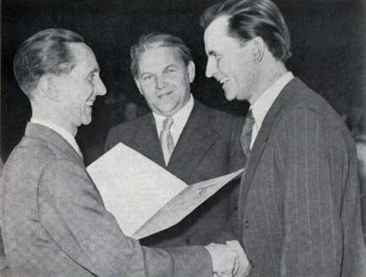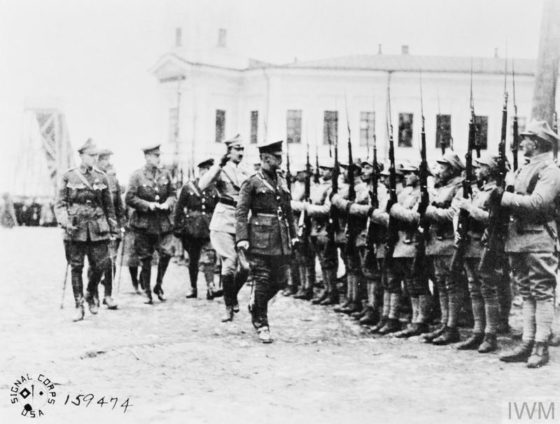
“The completed footage mysteriously vanished in the chaos of the Third Reich’s final days making Life Goes On perhaps the greatest lost artifact of Nazi Germany.”
FOR GERMANY, 1944 was a dark year indeed. News from the front was unremittingly bleak and few but the most die-hard Nazis expected anything but an inevitable defeat.
Yet Hitler’s own propaganda minister, Dr. Joseph Goebbels, was confident that he had a cure for the hopelessness that gripped the masses: Cinema. The Nazi spin doctor believed that the people needed movies — epic, feel-good, blockbusters that would distract, entertain and perhaps even inspire continued resistance. In short, they needed films like Das Leben Geht Weiter or “Life Goes On.”
A big budget extravaganza on the scale of Gone With the Wind, the movie told the story of plucky Berliners living in defiance of ceaseless Allied bombing. Life Goes On would bring together the Third Reich’s leading filmmakers, movie stars and musical composers. It would feature hundreds of extras and dazzling special effects. Goebbels expected the project to be his crowning cinematic achievement; instead it would prove to be an unmitigated disaster.
The production was mired in problems from the start while the cast and crew faced a seemingly endless series of delays. In fact, Germany’s surrendered before the shooting had wrapped. What’s more, the completed footage mysteriously vanished in the chaos of the Third Reich’s final days making Life Goes On perhaps the greatest lost artifact of Nazi Germany.

Pre-Production
Although credited to a trio of screenwriters, the Life Goes On script was actually driven by Goebbels himself. After seeing Mrs. Miniver, a 1942 Hollywood film about Londoners surviving the Blitz, the infamous information minister dreamed of making a German version of the celebrated movie. [1] The knock-off would focus on the trials and tribulations of the residents of one Berlin apartment complex in 1943 as they faced the horrors of enemy bombing. Ewald Martens was the film’s hero — a hard-working, patriotic scientist committed to developing a new super weapon he hopes will clear the skies of enemy aircraft. Spoiler alert: Martens eventually completes his work in time to save Germany, but not before his beloved wife is killed in an air raid.
In late 1944, Goebbels commissioned the accomplished director Wolfgang Liebeneiner to bring the story to the big screen. An all-star cast of Germany’s brightest stars from stage and screen were conscripted to appear in the film. The cast included actors like Gustav Knuth, Hilde Krahl, Marianne Hoppe and Heinrich George. [2] By that point, the Axis defeat was all but inevitable, yet Goebbels still pushed his director to have the movie completed as quickly as possible. He was still confident that Life Goes On would motivate German civilians to fight on. [3]

Shooting
Filming began in January of 1945 , just as Allied troops were driving into Germany itself. Ironically, by the time shooting commenced, many of the Berlin landmarks that were to appear in the film had long since been flattened by British and American air raids. Undeterred, Liebeneiner had massive replicas of whole city blocks painstakingly fabricated on a backlot not far from the actual ruins themselves. Valuable materials and manpower was even diverted from reconstruction efforts to build the make-believe replicas! [5] Despite the skyrocketing costs of the production, Goebbels had become obsessed with the movie and continued to bankroll it against all odds. That there were few movie houses still standing in the Fatherland, little electricity to run the projectors, and a population more interested in basic survival than watching a state-sponsored war movie mattered little to the Nazi propagandist.[6] The show would go on.
As shooting continued, new setbacks plagued the production. With civilians busy clearing rubble and fortifying German cities in the face of advancing Soviet armies, the extras needed to play Berlin’s civilian population were hard to come by. Instead, Goebbels authorized Eastern European forced labourers to serve as stand-ins for the ordinary Berliners. [7]
Eventually, widespread power outages and the approaching Red Army forced the film to relocate to a Luftwaffe base in the west, but soon even that set was coming under regular air attack by British planes. Filming continued into February and March at other locations. By April, with the Allies surging into the very heart of Germany, Liebeneiner was forced to shoot his film on the run, often finishing scenes only hours before his locations fell to the enemy. But with his commitment to the enterprise waning with each new challenge, the project’s days were clearly numbered. The filmmaker was reportedly even drafting an anti-Nazi ending for Life Goes On, one that he hoped might ingratiate him with the Allied conquerors.[8]

That’s a Wrap!
By the middle of April, with war only days from its fiery conclusion, Liebeneiner suspended the production once and for all. He disbanded his cast and crew and went into hiding with the uncompleted film. Goebbels, cut off in Hitler’s bunker, could wield no more influence over the filmmaker and would soon be dead anyway. Liebeneiner supposedly hid the undeveloped reels in a bombed out cathedral and then fled to safety. What happened next is unclear. Some accounts suggest that British soldiers recovered the film cans and inadvertently exposed them to light while opening them. Others record that one of the cameramen got to the reels first and hid them in a forest where they would never be found. Film historians in Germany have since tried to track down remnants of the movie, but have come up empty. Today, all that remains of the project are original storyboards and some newsreel footage of the production. [9]
Liebeneiner’s film career didn’t end with Life Goes On however. He went on to direct for the stage following the war. His biggest post war film was The Trapp Family, a 1950s West German film that would go on to inspire The Sound of Music. Liebeneiner died in 1987. [10]
(Originally published on July 13, 2012)
_____________________
SOURCES
1. http://www.imdb.com/title/tt0037867/
2. Feifer, George. “The Last Picture Show.” Military History Quarterly. Vol. 10, no.4 1998
3. Ibid
4. Ibid
5. Ibid
6. Ibid
7. Ibid
8. Ibid
9. Ibid
10. http://en.wikipedia.org/wiki/Wolfgang_Liebeneiner#Nazi_era










This was a most interesting post, sir, down to landmarks no longer standing to the usage of forced laborers and to missing tins! And if the film really was developed and then hidden, I believe the film itself will have deteriorated beyond use…
It’s entirely likely that is the case, unless of course they are safe in someone’s attic.
This is a very interesting article! I must admit I’ve never heard of this film.
Fascinating story – a “Holy Grail” of lost cinema footage.